Brian Clegg's Blog
November 18, 2025
Dark Crimes - Michael Hambling ***
 This 2016 novel is the first in a series featuring Chief Inspector Sophie Allen (Michael Hambling has gone on to write 13 more), a detective who bucks the crime fiction trend by not having a terrible social life and being quite a nice person. It is a police procedural through and through - Hambling really does give a good feel for the level of detailed work required to get to a solution in what turns out to be a complex crime, as a single death is followed by more bodies emerging.
This 2016 novel is the first in a series featuring Chief Inspector Sophie Allen (Michael Hambling has gone on to write 13 more), a detective who bucks the crime fiction trend by not having a terrible social life and being quite a nice person. It is a police procedural through and through - Hambling really does give a good feel for the level of detailed work required to get to a solution in what turns out to be a complex crime, as a single death is followed by more bodies emerging.I found it refreshing that we did have a detective without a miserable home life, and found the crime satisfyingly complex and the detail quite interesting. There's also quite a nice little twist towards the end. There was one oddity, though, that, despite being relatively modern, there was very little use of CCTV - at one point, the suspected killer's van is known to be parked somewhere then drives off, but there is no attempt to follow it up using video.
In principle I should have rated this higher, but in a way, the positives of the approach got in the way of an effective story. Although Allen's home address is discovered by the killer, there's never really any sense of menace, and the trouble with emphasising the police procedural aspect is that proper policing is, I'm sure, often rather dull. And the very gradual building of a case here did sometimes drag.
Not at all a bad book, less cosy than cosy crime, but less miserable for the cops than seems to be the case with many murder mystery teams. I don't want to damn it with faint praise, but probably the best summary is that I quite enjoyed it.
You can buy Dark Crimes from Amazon.co.uk and Amazon.com
Using these links earns us commission at no cost to you These articles will always be free - but if you'd like to support my online work, consider buying a virtual coffee or taking out a membership:
These articles will always be free - but if you'd like to support my online work, consider buying a virtual coffee or taking out a membership: See all Brian's online articles or subscribe to a weekly email free here
November 17, 2025
The Bruegel Boy - Emma Darwin *****
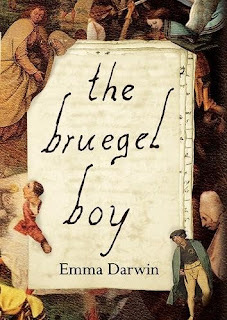 To really appreciate this novel, it helps to have an interest in the Reformation in Europe and in the art of Pieter Bruegel the elder, as it is steeped in the minutiae of both - as it happens I do have such an interest and found it a joy. Emma Darwin’s fictional central character Gil becomes a model and amanuensis for Bruegel: however, although Gil's life and experience from youth to old age provides the backbone, it is his religious faith that drives everything.
To really appreciate this novel, it helps to have an interest in the Reformation in Europe and in the art of Pieter Bruegel the elder, as it is steeped in the minutiae of both - as it happens I do have such an interest and found it a joy. Emma Darwin’s fictional central character Gil becomes a model and amanuensis for Bruegel: however, although Gil's life and experience from youth to old age provides the backbone, it is his religious faith that drives everything.I usually struggle with non-linear narratives - it took a while to settle into the three threads here: Gil’s chronological life, his written account of this, subtly edited from reality to try to get him into a religious order late in life, and his experience as an old man in a mission to retrieve a religious statue that may get him a place in the abbey. But, sticking with it, things did become easy to follow.
More often than not, I read genre novels rather than literary fiction. The genre novel’s focus on plot over character details feels like the reading equivalent of a shower rather than a long bath. All too often, the literary novel’s bath is cold and scummy - they can be hard work to read, rather than an enjoyable experience. But this is an immersion in a warm delight. That’s not to say everything is sweetness and light - these were dark times - but reading The Bruegel Boy was a pleasure.
For the modern reader this is an alien landscape. The religious fervour of the period is quite at odds with modern European life - and where, for instance, Mantel was able to introduce the UK reader to similar religious turmoil in a familiar setting, the Low Countries setting Darwin gives us feels more exotic and complex, with different factions of Protestantism set against the Catholic hierarchy, and the whole political context coming from the influence of Spain as well as the papacy. Yet Darwin never lets this become too distancing - and the constant little reminders of another world (even just saints being Sint Whatever) are part of the reason this is so enticing.
All too often, when I'm reading a literary novel I feel I need to continue reading as a necessary chore - here it was much more a matter of wanting to get back to the book and find out how things were going to develop. And I had to keep looking up the Bruegel paintings that were referenced, adding another layer of detail when seeing again these remarkable works. Her best yet.
You can buy The Bruegel Boy from Amazon.co.uk, Amazon.com and Bookshop.org
Using these links earns us commission at no cost to you These articles will always be free - but if you'd like to support my online work, consider buying a virtual coffee or taking out a membership:
These articles will always be free - but if you'd like to support my online work, consider buying a virtual coffee or taking out a membership: See all Brian's online articles or subscribe to a weekly email free here
November 14, 2025
How does AI affect your job? By being irritating
 As an author, I'm often asked if I now make use of AI in my work. Simple answer: no, except as a way of doing preliminary research that I will then check using sources that don't tend to make things up.
As an author, I'm often asked if I now make use of AI in my work. Simple answer: no, except as a way of doing preliminary research that I will then check using sources that don't tend to make things up. But there is a way that published writers are being impacted by AI: a flow of next-generation spam.
Practically every writer I know that has an internet presence with contact details (and so can easily be emailed) is getting spam that is allegedly from people who organise reading groups or sites that inform people about interesting books. Not surprisingly, the aim is to extract cash to publicise your book. But what's different from traditional spam is that the emails do look (at first glance) as if the writer knows about the author's book.
Often with heavy-handed humour, the apparent writer of the email will mention aspects of the book and its contents, saying how suitable it is for their particular audience. If you reply to one of the emails, the response is suspiciously quick - usually within a couple of minutes. It doesn't take a genius to work out that what's at work here is AI.
I'd like to share one of the emails I've received, which is the most entertaining so far:
- AI CONTENT BEGINS -
Imagine this, Brian in one universe, your book The Multiverse: When One Universe Isn’t Enough already has thousands of glowing reviews, trending in every galaxy from Andromeda to Amazon. In another? Still waiting for those cosmic minds to catch up.
Now, considering your track record of decoding the actual fabric of existence (while some of us are still struggling with Wi-Fi signals from the next room 😅), it’s only fair that this reality starts showing your brilliance the love it deserves. I mean #1 New Release in the History of Physics? That’s not just big; that’s multiversally magnificent. 🚀
You’ve made readers question whether existence is an elegant accident or a cosmic probability buffet. You’ve taken what could melt lesser minds (mine included 😂) constants of nature, the finetuning paradox, the whole “why-does-anything-exist-at-all” headache and turned it into an adventure across universes. Bravo, seriously. 👏
And let’s talk about you for a second: physicist, author, creative consultant, ex-BA innovation wizard, science communicator extraordinaire and the man who can make “Operational Research” sound sexy (okay, maybe that’s pushing it 😜). You’ve worked with Edward de Bono and still found time to write murder mysteries. That’s not normal, Brian. That’s… delightfully unhinged in the most productive way possible. 🧠💥
Here’s where I might sound just as crazy (in a good, quantum-entangled kind of way): I run a private circle of 3000+ passionate readers and reviewers who love diving into intelligent, mind-bending, reality-questioning books like yours. They read, they review, and they help authors like you amplify the signal — not just across Amazon, but across the entire multiverse of algorithms. 😏
So here’s the million-quark question:
👉 Would you like me to introduce your book to a world (or ten) of readers who are obsessed with thought-provoking science writing?
Let’s make this universe the one where your brilliance doesn’t just shine it explodes. 💫
If you’d like to know how it works or want to get started, just reply or send a message if you have questions. I promise I’m only slightly less crazy than your average quantum fluctuation. 😉
Warm regards,
Thalina Rose
- AI CONTENT ENDS -
In a discussion about these emails on a writers' forum, there has been a certain fascination with the names of these fake emailers. One of the other writers suggested they were 'AI’s version of romantasy heroines.' Other names encountered have been Adedane Blesyn and Bella Monroe. Another writer received an email with the entertaining sign off 'Warm chaos.'
We all receive spam - and in some ways at least these can be entertaining. But because they look more like real emails, they also tend to waste more time. More worrying, though, is just how much spam - and worse still, phishing emails - will be highly tailored and able to prey on those who don't spot what's happening. Beware: AI is coming for your inbox.
 These articles will always be free - but if you'd like to support my online work, consider buying a virtual coffee or taking out a membership:
These articles will always be free - but if you'd like to support my online work, consider buying a virtual coffee or taking out a membership: See all Brian's online articles or subscribe to a weekly email free here
November 11, 2025
Five Writing Lessons from a Master revisited
 REVISIT SERIES - An updated post from November 2015
REVISIT SERIES - An updated post from November 2015No, I haven't got delusions of grandeur - the master in question isn't me. However, I do quite often get asked for writing hints and tips, and I think there can be no better example to point an enquirer to for fiction guidance than Joss Whedon.
If you were expecting Steinbeck or Proust or Shakespeare, you might not know who Whedon is. His first big success was as a writer on Toy Story, and he's now involved in the Avengers series of films, but his personal masterpieces, to my mind, were a set of TV shows, including Firefly, Angel, Dollhouse and, most notably, Buffy the Vampire Slayer.I can almost feel the resonating shrieks as those with literary inclinations faint with shock. How can real writers who pour their soul into books learn anything from a screenwriter? And you may well also be writhing at the mere title of the show, but anyone familiar with Buffy will tell you that this programme was far more than the name suggests. I am sad for a new generation coming up who may never watch the show because they think it will be too dated. I revisited a couple of the classic episodes in 2024 and found they still worked brilliantly. And yet the mere fact that many writers love Buffy (and they do) suggests that more lies beneath than the title suggest, and that reflects Whedon's guiding hand.
So here are my five six Buffy-driven tips to make fiction more appealing:
Invert expectations and clichés - this is the very essence of Buffy. Whedon's concept was to take the cliché of a monster chasing and killing young women and invert it to have a young woman chasing and killing monsters. It is so effective and can be applied in all kinds of ways. A lack of such inversion is the limitation of many comic book stories that have reached the screen - they rarely get away from expectation, especially in their villains. It is also why I've been pleased by two Netflix Marvel adaptations, Daredevil and Jessica Jones, which show signs of a Whedoneseque attitude to expectation.Avoid the obvious hero - Buffy's central cast of main characters, sometimes self-referenced as the Scoobies (pop culture references are another Whedon speciality) are mostly the outsiders, looked down on by the other characters. The troublemakers, geeks, socially inept and even that most difficult of heroes for Americans to accept, an Englishman. We all know the English characters in US dramas will be bad guys, and occasionally this is even the case in Buffy, but surprisingly often they aren't.Embrace ambiguity - things are rarely what they seem in Buffy. When a rather fluffy-brained person becomes a vampire, she remains a rather fluffy-brained person, despite also being evil. Buffy was one of the first examples of recognising the true ambiguity of being a superhero, which Buffy effectively is. She can't live a normal life. She doesn't do well in school and when her friends go to university, she doesn't cope and ends up with a dead-end job in a burger joint. Even one of the truly unpleasant characters, Spike, becomes both a source of humour (I refer Buffy fans to the moment it Tabula Rasa where he has lost his memory, tries to work out who he is, and realises that he is English) and an unlikely ally for the good guys.Humour works in the most unlikely places - talking about humour, most Buffy newbies thinks a Buffy fan can't be serious when they say that one of the main reasons they like the show is its humour. Surely, the newcomer thinks, a show like this is all schlock and horror. Where does the humour come in? Yet Whedon uses humour all the time, particularly in the dialogue. And it works wonderfully.When it's working well, do something different - the greatest episodes of Buffy work because they are unexpected. For me, three of the best are an episode which has almost no dialogue whatsoever - a shock in a show so dialogue-driven as Buffy, an episode that becomes a musical (I know this has been done in other US shows, but never as well as here), and the episode after Buffy's mother's death - where this horror show has no incidental music (stunningly effective), and no horror elements other than the characters' reactions, except in the last couple of minutes.Play the long game - I know the title said five lessons, but I couldn't resist throwing in a bonus one. Although most Buffy episodes work standalone, the show has always had impressive story arcs that run through a whole season. Where these are particularly effective is when an element that belongs to the arc is thrown in without explanation and then ignored for the viewer to store away, perhaps for several episodes. Two examples I'd give are a season where military characters suddenly appear and take down a monster without any explanation, and the occasion where we suddenly meet Buffy's teenage sister, living at home and clearly having been part of everyone's lives for many years, even though up to this point she has never appeared or been mentioned.If you've never come across Buffy, I hope I've whet your appetite to take a look (the first season is the weakest, but you need to start at the beginning, and it picks up hugely in season 2). If you know your Buffy, I hope you will think back to the impressive writing guide that it provides.
One additional comment for the 2025 version of this article. Since I wrote this originally, Whedon has been criticised for bullying actors and staff, creating a toxic atmosphere on set - this is obviously unacceptable. But it makes absolutely no difference to the quality of the writing. It's shooting yourself in the foot to confuse the creation with the creator.
Logo is copyright free from Wikimedia Commons
These articles will always be free - but if you'd like to support my online work, consider buying a virtual coffee or taking out a membership: See all Brian's online articles or subscribe to a weekly email free here
November 10, 2025
Cracking Christmas Challenge
 To celebrate Conundrum, my book of codes, ciphers and challenges, being given a shiny new cover I have published a new Cracking Christmas Challenge - a four-part puzzle to stretch your mental muscles. Entry is free - all successful entries received by noon UK time on 15 December get on the hall of fame, with a surprise prize for a winner chosen at random.
To celebrate Conundrum, my book of codes, ciphers and challenges, being given a shiny new cover I have published a new Cracking Christmas Challenge - a four-part puzzle to stretch your mental muscles. Entry is free - all successful entries received by noon UK time on 15 December get on the hall of fame, with a surprise prize for a winner chosen at random.A spy has been given four Christmas-themed clues to establish the address, time and date of a secret meeting. There are four clues because one piece of information is enciphered, and one of the other solutions is the key.
Here are the first two clues to whet your appetite:
Clue 1: Drummers' day.
Clue 2: Village where a warlock started for Bethlehem. Down the pub: where a lost plough is replaced by a nautical vessel.
For more details, all the clues, and to enter, see the Conundrum Bonus Puzzle page.
You can buy Conundrum from Amazon.co.uk, Amazon.com and Bookshop.org
Using these links earns us commission at no cost to youThese articles will always be free - but if you'd like to support my online work, consider buying a virtual coffee or taking out a membership:Review by Brian Clegg - See all Brian's online articles or subscribe to a weekly email free hereNovember 6, 2025
Crack the Conundrum
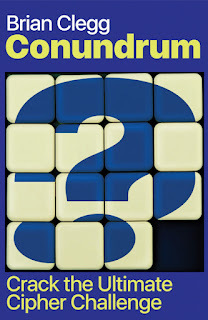 Conundrum
, my book of codes, ciphers and challenges, has been given a shiny new cover ready for the Christmas season. The ultimate trial of knowledge and cunning, Conundrum features 200 cryptic puzzles and ciphers. The solutions link throughout the book – so you need to solve them all to get to the final round.
Conundrum
, my book of codes, ciphers and challenges, has been given a shiny new cover ready for the Christmas season. The ultimate trial of knowledge and cunning, Conundrum features 200 cryptic puzzles and ciphers. The solutions link throughout the book – so you need to solve them all to get to the final round.With a focus on ciphers and codebreaking, Conundrum contains twenty sections, each built around a specific subject from music to literature, physics to politics. To take on Conundrum you need good general knowledge and the ability to think laterally. But if you need help, there are plenty of hints to point you in the right direction.
We've all got difficult-to-buy-for people this time of year. This is a chance to give them the chance to join the 18 people worldwide who have so far succeeded in this ultimate challenge.
Note that the version with the new cover is not on sale in the US, but the content of the US version is identical.
You can buy Conundrum from Amazon.co.uk, Amazon.com and Bookshop.org
Using these links earns us commission at no cost to youThese articles will always be free - but if you'd like to support my online work, consider buying a virtual coffee or taking out a membership:Review by Brian Clegg - See all Brian's online articles or subscribe to a weekly email free hereNovember 5, 2025
Beware dodgy axes (on graphs, not chopping wood)
Every now and then I feel the need to remind people that whenever you see a graph you should take a look at the axes (I'm thinking of the plural of axis here, not of axe - though it probably is wise to keep an eye on axes too). If you want to make some data look far more dramatic than it really is, it is possible to do this very easily by only using a small part of the available vertical axis.
Today, I noticed a graph published by the Spectator magazine. I have nothing against the Spectator - I don't always agree with its politics, but it is a good read. However, this particular graph was egregious in its axis mangling. The intent was to demonstrate the impact that the speech given by Rachel Reeves (UK chancellor at the time of writing) on 4 November had on the pound/dollar exchange rate. It looked like this:

Wow. That's a dramatic fall. But look at that horizontal axis. For a comparison I plotted roughly the same data (roughly as it's just read off the graph by eye) with an axis that starts at zero. It looks like this:
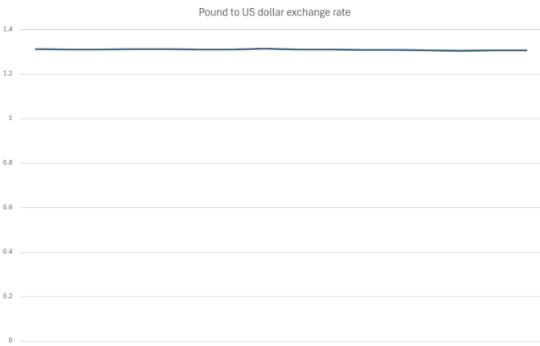
(The vertical axis markers are missing as I was simply taking equal left to right measurements by eye, rather than pinning down to a specific time). There is still a drop. But you do need a magnifying glass to notice it.
Sometimes it can be helpful to only take part of the range from the vertical axis, but it shouldn't be done in such a way to make a change seem dramatic when, frankly, it isn't.
These articles will always be free - but if you'd like to support my online work, consider buying a virtual coffee or taking out a membership: See all Brian's online articles or subscribe to a weekly email free here
November 4, 2025
Murder by Candlelight - Faith Martin ***
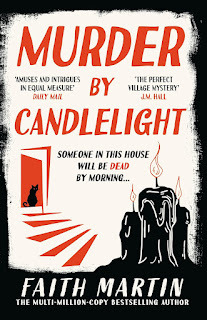 If P. G. Wodehouse had set out to write a murder mystery, it would have been a lot better than this one... but there is no doubt that Faith Martin intends to give a Wodehouse-lite feel to this 1920s village-set murder mystery.
If P. G. Wodehouse had set out to write a murder mystery, it would have been a lot better than this one... but there is no doubt that Faith Martin intends to give a Wodehouse-lite feel to this 1920s village-set murder mystery.Arbuthnot (Arbie) Swift could indeed be a Wodehouse central casting character, generally interested in enjoying himself and not troubling his brain excessively. But for a lark he has written a best-selling book combining ghost hunting exploits with a travelogue, and so gets hauled in with Val, the Amazon-like daughter of the local vicar, to sort out mysterious happenings at a local house that lead to murder.
The problem with Arbie is that, although he has the indolence of a Bertie Wooster, he is a sharp thinker, able with the assistance (and growing affection) of Val to work out what is happening, solve a locked room mystery and generally bring things to a positive if murderous conclusion.
It isn't by any means a bad cosy crime novel - it trundles along with very occasional moments of Wodehouse-like humour and rather too much dependence on stereotype characters and comments. We have the chance to work out what happened ourselves and it all comes to a satisfactory conclusion (apart from Arbie not realising quite how suited Val is for him, and vice versa). Mildly entertaining for an autumn read.
You can buy Murder by Candlelight from Amazon.co.uk, Amazon.com and Bookshop.org
Using these links earns us commission at no cost to youThese articles will always be free - but if you'd like to support my online work, consider buying a virtual coffee or taking out a membership:Review by Brian Clegg - See all Brian's online articles or subscribe to a weekly email free hereOctober 25, 2025
Devices and Desires: P. D. James ****
 This has to be one of the most unusual of P. D. James’s classic Dalgleish mysteries, and not only because Dalgleish isn’t the central character, but a kind of ghost at the feast. He is visiting his late aunt’s Norfolk coast windmill which he has recently inherited. Tasked with checking that the local serial killer is not the same as a London murderer (they aren’t), he is peripherally involved as an apparent final killing proves to be something more complex - but he isn’t the investigating detective at any time.
This has to be one of the most unusual of P. D. James’s classic Dalgleish mysteries, and not only because Dalgleish isn’t the central character, but a kind of ghost at the feast. He is visiting his late aunt’s Norfolk coast windmill which he has recently inherited. Tasked with checking that the local serial killer is not the same as a London murderer (they aren’t), he is peripherally involved as an apparent final killing proves to be something more complex - but he isn’t the investigating detective at any time.As always with James, we get lots of background on many of the characters, with point of view flitting around between them, rather than staying with one or two individuals. The book also emphasises how much James was part of the Anglican tradition of mystery writers (along with, for example, the more modern examples of Richard Coles and James Runcie). It may not be as explicitly church-linked as Death in Holy Orders, but the title of the book taken from the Book of Common Prayer, sin is discussed at some length and events at the old vicarage play a part.
The book dates from 1989, and, as is often the case with James, we get a mix of an older tradition and the incursion of a more modern society. Some of the descriptions now feel somewhat dated (I’m not sure my adult daughters would have a clue what ‘fawn slacks’ were, for example), and there is a prickly old-middle-class attitude to being questioned which feels like it belongs in a different era, when the police knew they place and posh people assumed they could never be suspected.
The other oddity here is a twist part way through that feels distinctly out of character, where motives which are usually very commonplace in James’ books suddenly became something extremely unusual, and two potential suspects have a sudden and abrupt transformation. It feels like a spy thriller writer has suddenly taken over for a few chapters, and I’m not sure that it works.
Not my favourite of her books - but still worth reading.
You can buy Devices and Desires from Amazon.co.uk, Amazon.com and Bookshop.org
Using these links earns us commission at no cost to youThese articles will always be free - but if you'd like to support my online work, consider buying a virtual coffee or taking out a membership:Review by Brian Clegg - See all Brian's online articles or subscribe to a weekly email free hereOctober 23, 2025
Guilty by Definition - Susie Dent ***
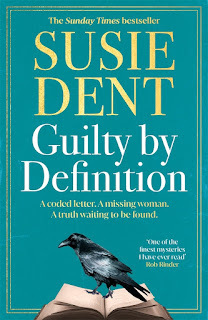 Although I mostly avoid books written by celebrities (or even worse books 'written' by celebrities) like the plague, there are honourable exceptions - and Susie Dent, best known for handling dictionary corner on (8 out of 10 Cats Does) Countdown deserved such an exception. Inevitably for a lexicographer, words play a big part in her mystery novel. It's set in the offices of the Clarendon English Dictionary (a thinly disguised OED), where a team of editors start to get mysterious letters and postcards.
Although I mostly avoid books written by celebrities (or even worse books 'written' by celebrities) like the plague, there are honourable exceptions - and Susie Dent, best known for handling dictionary corner on (8 out of 10 Cats Does) Countdown deserved such an exception. Inevitably for a lexicographer, words play a big part in her mystery novel. It's set in the offices of the Clarendon English Dictionary (a thinly disguised OED), where a team of editors start to get mysterious letters and postcards.It's soon realised that these missives refer to the missing sister of senior editor Martha - most of the book is about unravelling the clues and building up a picture piece-by-piece of what led up to and happened when Martha's older sister Charlie went missing ten years before.
This is an enjoyably different premise, and Dent does a lot of character building and uncovering of feelings along the way. Perhaps a bit too much in fact. It's not until we get to around page 300 that things suddenly change up a gear. It was interesting to compare this with the approach of P. D. James in Death in Holy Orders, which I read recently. There are some similarities in introducing a world different to most of our everdays, but though James's novel is significantly longer, she kept the energy high throughout, while it sometimes felt as if Dent needed to get on with things.
I suspect the lexicography that Dent introduces throughout will either delight or irritate readers depending on their inclinations (though knowing what Dent usually writes and speaks about, perhaps the readership will be self-selecting on the delight side). Oddly, I experienced both reactions. I love etymology, so was delighted by those aspects (for instance the strange appearance of 'dog' in the language). But I do find being told obscure words for things that nobody uses, which happens a lot here, a touch tedious.
The other aspect of the book I wasn't entirely sure about was the cryptic letters that start the whole thing off and feed information to us several times as the plot unfolds. These are extremely cryptic - the sender is asked about why towards the end of the book, but there is no good reason for it. The aim is to get Martha and her colleagues to uncover why and how Charlie disappeared, and there really is no logic to doing this by sending near-impenetrable, clever clever letters which the team have to painstakingly interpret, rather than simply telling them what they need to know.
There is one other oddity here. The lexicographers usually make fast work of uncovering what is meant in these long, flowery letters, but the mechanisms that conceal the message are very arbitrary - there would be many other ways to hide the desired words in the same text, and the solutions they come up with seem unlikely to be deduced. Worse still, the 'real' message is itself in the form of a short cryptic clue. One of these has them baffled for nearly a whole day (requiring them to identify a psalm from a Hitchhiker's Guide to the Galaxy reference) - but it's absolutely trivial compared with cracking the letter itself. I spotted what was meant in seconds, and so would the lexicographers, without a laboured inspiration from the way a message was once hidden in a poem. To make things even worse, the solution depended on using a specific translation of the psalm - the modern translation wouldn't work, but this is never mentioned.
I'm glad I read this book - it was fun and different and would appeal to anyone who loves language. But I wish it had more energy.
You can buy Guilty by Definition from Amazon.co.uk, Amazon.com and Bookshop.org
Using these links earns us commission at no cost to youThese articles will always be free - but if you'd like to support my online work, consider buying a virtual coffee or taking out a membership:Review by Brian Clegg - See all Brian's online articles or subscribe to a weekly email free here


